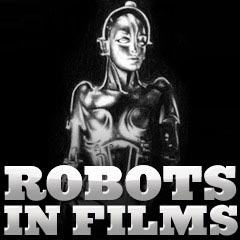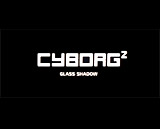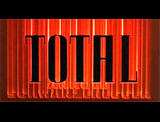
|
A Complete Illustrated History of Robots in the Movies 1987 to 1990 |
| Film/Year, Name of Robot and Film Description | ||

|
*batteries not included (1987) (aka Miracle on 8th Street)
In this Steven Spielberg-produced film, mysterious philanthropic, flying-saucer-shaped, living 'fix-it' mechanical robots came to the aid of elderly tenants (including diner owners Frank and Faye Riley, Hume Cronyn and Jessica Tandy). The seniors were threatened with eviction in their soon-to-be-demolished New York apartment building. The two good-natured but shy adult fix-it robots had three babies: Wheems, Jetsom and Flotsom, and continually repaired broken items, as well as served cheeseburgers in the diner. The film was a composite of E.T.: The Extra-Terrestrial (1982) and Cocoon (1985). |

"Fix-It" Robots |

|
Cherry 2000 (1987)
This science-fiction futuristic film had a tagline describing the title character: "She's Blond, Beautiful and Forever Young." In a post-apocalyptic world in the year 2017, Sam Treadwell (David Andrews), the head of an Anaheim recycling plant, employed a perfect girlfriend -- a rare, irreplaceable, top-of-the-line blonde-haired sex robot named Cherry 2000 (Pamela Gidley). She was programmed with a shiny "chip" (similar to a quarter-sized mini CD) behind her ear. However, he found it difficult to replace her when she shorted out (wearing a tight red dress and yellow rubber gloves) when they were love-making on the floor and soapy water overflowed. When Sam went to a robot factory to get a replacement body for his girlfriend, his choices included Robby the Robot (from Forbidden Planet (1956) and Gort (from The Day the Earth Stood Still (1951)). |
  Cherry 2000  
|

|
Making Mr. Right (1987)
In Susan Seidelman's PG-13 sci-fi comedic romance, John Malkovich played a dual role:
Comic confusion arose when the design company Chemtech Corporation's PR New Wave "image consultant" Frankie Stone (Ann Magnuson), who had promoted, packaged and 'sold' Ulysses (with a detachable, spinning head) to the American public, also taught the android about emotions, sensitivity and love. Frankie ultimately fell in love with the more evolved and sexually-satisfying male robot, when Ulysses switched roles with his creator. |
  Dr. Peters and Ulysses |

|
Not Quite Human (1987-1992) (TV movies)
A series of three TV movies (airing on the Disney Channel), all sci-fi comedies ("coming-of-age") and family films, were based on the young adult book series of six novels (published from 1985-1986) by Seth McEvoy. The stories told about a widower scientist, Dr. Jonas Carson (Alan Thicke), a single father who created a "not quite human" teenaged android named Chip (Jay Underwood). The android posed as a high-school student, and possessed great strength, was impervious to fire, and had a photographic memory. His head movements were jerky, and he often took things literally. He attended school with Carson's daughter Becky (Robyn Lively). In the developing plot, Carson's former boss Gordon Vogel (Joseph Bologna), a defense contractor, had plans to kidnap the android and reprogram him into a military machine. |
   Chip (Jay Underwood) |
|
RoboCop (1987)
The first film in the series, by director Paul Verhoeven, was a graphically-violent film set in dystopic, crime-filled futuristic Detroit, with the tagline: "Part man, part machine, all cop." It featured a cyborg - a half-human (with repressed and fragmented human memories), half-robotic, bullet-proofed, crime-fighting supercop (Peter Weller/Robert John Burke), officer Alex J. Murphy's alter-ego. Alex was killed in the line of duty as a cop, and brought back as an invincible cyborg called RoboCop. The robotic enforcer was built by the corrupt local law-enforcement organization called the OmniConsumer Products Corporation (OCP). RoboCop took various elements of past robotic designs, such as Gort's head, "Fake" Maria's legs, and C-3PO's body. Beneath its exterior, it had a human face. When in sleep mode (in a chair), it was battery-recharged and reconfigured. The film also featured the stop-motion animated ED-209 (Enforcement Droid Series 209) robot - a giant, awkward, faceless, hard-surfaced, top-heavy, self-sufficient, law enforcement robot for "urban pacification" - heralded as "a self-sufficient, law-enforcement robot" and "the hot military product for the next decade." During an experimental demonstration in the boardroom, after the crouched, combat-stanced ED-209 gave a warning when a gun was threateningly pointed at it: "Please put down your weapon. You have 20 seconds to comply," it malfunctioned and killed its opponent Kinney (Kevin/Ken Page) with a violent volley of shots from its Gatling gun hands, even though the weapon was surrendered. The faulty robot was excused by OCP Senior President Dick Jones (Ronny Cox): "I'm sure it's only a glitch, a temporary setback." Sequels: RoboCop 2 (1990), RoboCop 3 (1993) |
 Robocop     ED-209 |

|
Spaceballs (1987)
Mel Brooks' science fiction comedy fantasy featured a wise-cracking character named Dot Matrix (Lorene Yarnell, voice of Joan Rivers). Dot Matrix was Princess Vespa's (Daphne Zuniga) gold-plated, protective Droid of Honor for her wedding on the peace-loving planet of Druidia. The robot resembled a female version of Star Wars' C-3PO. Her name referred to a non-laser type of serial dot matrix computer printer that printed dots within a grid pattern. |
  Dot Matrix |

|
Back to the Future Part II (1989)
This sequel began where the first film ended. It was both more somber and dark, with a very complex and sophisticated plot involving time-travel. The film opened with Marty McFly (Michael J. Fox) and girlfriend Jennifer Parker (now Elisabeth Shue) joining Dr. Emmett "Doc" Brown (Christopher Lloyd) in time-travel ("back to the future") in his DeLorean to October 21, 2015. Marty pretended to be his own son, Marty, Jr. (also Michael J. Fox) to stand up to Biff's 19 year-old goading grandson Griff (Thomas F. Wilson) in Cafe 80's. Griff continued the tradition of the Tannens in bullying the McFly family, now with the reported aid of bionic implants (to give him enhanced strength, speed, and taller stature, and the ability to automatically block punches). |
 Biff Tannen (Thomas F. Wilson)  Biff Tannen in 2015 (Thomas F. Wilson)  Griff in 2015 (Thomas F. Wilson) |



|
Cyborg (1989)
In this post-apocalyptic martial arts film, the starring character was not the cyborg (it was basically a red-herring for a film title). This cyborg film was typical of many that came out in the 1990s, including Cyborg Cop (1993), Cyborg Cop II (1994), and Cyborg Cop III (1995) (aka Cyborg Soldier). Jean-Claude Van Damme starred as "the first hero of the 21st century," a mercenary named Gibson Rickenbacker whose mission was the rescue of a beautiful, but abducted cyborg Pearl Prophet (Dayle Haddon) from evil kidnapper Fender Tremolo (Vincent Klyn) and his band of "flesh pirates." Pearl became a cyborg in order to programmatically store and transport vital information that might help produce a cure for a plague that was slowly killing off humanity. The film was followed with a number of sequels:
|
  Pearl Prophet |

|
Darkman (1990)
Director Sam Raimi's comic-book style superhero action-horror film was adapted from the director's own short story. It was Raimi's first big-budget Hollywood studio film. It starred Liam Neeson as vengeful burn victim scientist Dr. Peyton Westlake/Darkman, a tormented hero with a disfigured face. He was continuing to experiment with photosensitive, synthetic skin (his own invention) after he almost lost his life in a horrific explosion. Using the skin as raw material, the tormented anti-hero created various disguises (but they only lasted 100 minutes per disguise) that helped him hide his disfigurement from the world, as he sought vigilante revenge on his enemies ("I'm everyone and no one, everything and nothing. Call me Darkman").
|

Darkman  
The Skin-Making Mold Machine |

|
Edward Scissorhands (1990)
Johnny Depp starred as shy, creative, white-faced, Frankenstein-like, unfinished Edward Scissorhands, an artificial life-form with unique scissor-hands - perfect for hedge and giant ice sculpting. Reclusive, kindly Inventor 'father' (Vincent Price in his last film role) died before he could install real hands on the inherently-good 'son.' Before being invited to live with a suburban family, Edward lived a lonely and naive existence in a castle overlooking the neighborhood. |
 Edward Scissorhands  
With 'Father' Inventor (Vincent Price) |

|
Hardware (1990, UK/US)
In this low-budget, cyber-punkish sci-fi horror hybrid film, an android head-helmet was found in the radioactive desert wasteland (previously in an area of New Jersey before an apocalypse) by an unnamed scavenger nomad (Carl McCoy). Moses Baxter (Dylan McDermott) acquired the junked robot and gave it as a Christmas gift to his metalwork artist/girlfriend Jill Grakowski (Stacey Travis) who used it in one of her blowtorch and chain-saw sculptures. The multi-limbed, intelligent military droid was originally government-programmed to kill people, without prejudice, as a means of population control (via the 'Emergency Population Control Bill'). The droid was named after a Biblical verse, Mark 13 ("Let no flesh be spared"). The humanoid skull (with an American flag painted on its headpiece) came to life (on Christmas Day, significantly) in her sculpture - the droid reconstructed itself from the various pieces of junk hardware in Jill's apartment, with glowing red eyes and a computer motherboard in the shape of a pentagram, claws, and a powerdrill. It then went on a killing rampage (with high-tech lasers and weapons). The misogynistic MARK 13 first targeted Jill alone in her secure apartment, and conducted a simulated rape by forcing a revolving metal drill between her legs. The droid's fatal flaw was an inability to insulate against moisture - Jill lured the killer machine into her shower where she smashed it into pieces. |
 M.A.R.K. 13  
|

|
Robot Jox (1990)
In this Stuart Gordon film, warfare was strictly forbidden between nations following a WWIII nuclear holocaust. However, the two major nations, the American-like "Western Market" and the Russian alliance "Confederation" could war against each other on large vast playing fields - but vicariously. They could fight by using giant mechanical robots, human-piloted by gladiator-like 'jockies' (or jox). The film's tagline described them as the "ultimate killing machine. Part Man. Part Metal." The robots were equipped with various weapons, including lasers, missiles, and cannons. To be exacting, however, they were not really robots but anthropomorphic-controlled vehicles - that is, the movements of the giant robot mimicked the actions of the jox in a control harness, while weapons were fired by a combination of joy sticks, switches, and buttons. |
   Giant Mega Robots |

|
Spaced Invaders (1990)
Director/co-writer Patrick Read Johnson's sci-fi comedy, expensively financed by Disney, was a box-office disaster. The parody alien invasion film was advertised with a few taglines: "For years, science has speculated on the existence of intelligent life in space...Now, there is living proof there is no such thing," and "Earth will never be the same." It was another example that alien life was no longer threatening, after the popularity of Close Encounters of the Third Kind (1977) and E.T.: The Extra-Terrestrial (1982). In the story set in the rural Illinois town of Big Bean, a radio-station was re-broadcasting Orson Welles' 'War of the Worlds' 1938 radio play on its 50th anniversary (on Halloween). Meanwhile, a planetary warfare was occurring between:
It was stated: "To secure our complete success, all ships throughout the galaxy have been equipped with Enforcer Drones to remove any weak links in the command chain. Any deviation from the Master Invasion Plan will result in immediate disciplinary review." When one of the Martian commanders complained, "I'll not send my boys out to Arcturas with an Enforcer Drone breathing down my neck," he was zapped into a charcoaled, smoking skeleton. The other commanders quickly complied. One of the civilian Martian asteroid patrol ships, lost in space, picked up the town's radio signal. They came to believe that Earth was the intended invasion target, and descended upon Big Bean. The aliens were short-statured with big green heads (and antennae), and possessed advanced technology. Five misguided Martians in the ship included:
Because it was Halloween, every local in town at first thought the Martians were costumed Halloween trick-or-treaters. But the town's recently-widowed Sheriff Sam Hoxly (Douglas Barr) was suspicious, as was his daughter Kathy Hoxly (Ariana Richards) and an old farmer named Wrenchmuller (Royal Dano) who owned the barn where the Martians had crash-landed. Kathy became friends with the Martians' little robot Shortstuff (voice of Kirk Thatcher), nicknamed "Scout-in-a-Can." It could collapse into a sphere and was considered "smart, efficient, easy to use and expendable." Another of her friends, dressed in a duck costume, was Brian Hampton (the Duck) (J.J. Anderson). In the conclusion, the Martians determined that they had made a big mistake, and were attempting to leave, although the ship's Enforcer Drone wouldn't allow them until it was destroyed with dynamite. |
  Enforcer Drone  Martians  Costumed Kathy (Ariana Richards) and Brian (the Duck) (J.J. Anderson) 
 Shortstuff |
 
|
Total Recall (1990)
In the film's futuristic world of 2084, taxi drivers were replaced by robotic automatons called "Johnny Cabs" (voice of Robert Picardo). When asked by Mars virtual reality secret agent Douglas Quaid (Arnold Schwarzenegger), "Where am I?," the whistling 'Johnny Cab' replied: "You're in a Johnny Cab." When Quaid again asked: "I mean, what am I doing here?...How did I get in this taxi?," the 'Johnny Cab' robot replied common-sensically: "The door opened. You got in," and then rolled its eyes. Later, when pursued in a car chase sequence, Quaid jumped in another Johnny Cab and in anger (after swearing at the robot), grabbed the robot and tore him from the gear mechanism attached to the floor, and threw him in the back seat. As the cab sped away amidst gunfire, the robot comically cautioned: "Fasten your seat belt." When Quaid escaped and left the cab, the robot chirped: "The fare is 18 credits, please," to which Quaid responded: "Sue me, dickhead," causing the robot to flare up and run the cab into a wall to create a fiery explosion - a defense mechanism to prevent unpaid fares. The tactic was unsuccessful in this case. |
 
Johnny Cab |